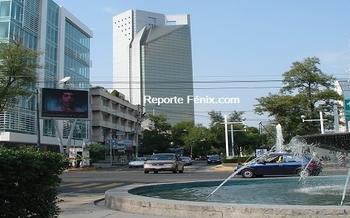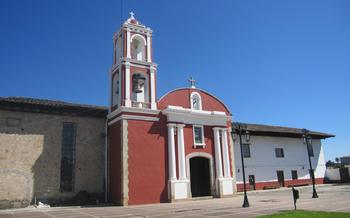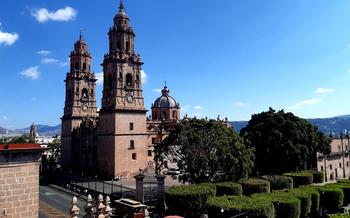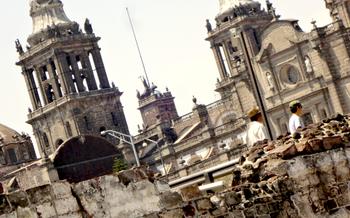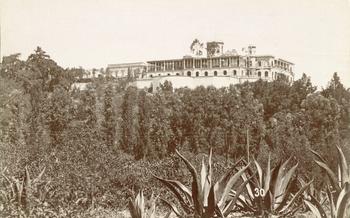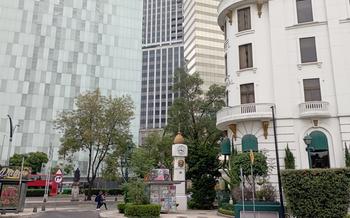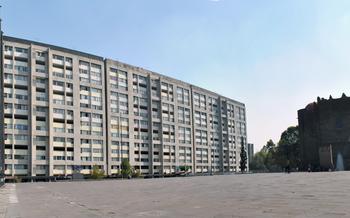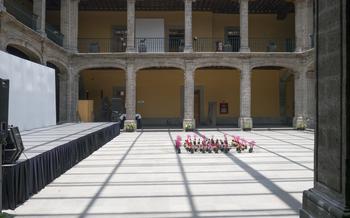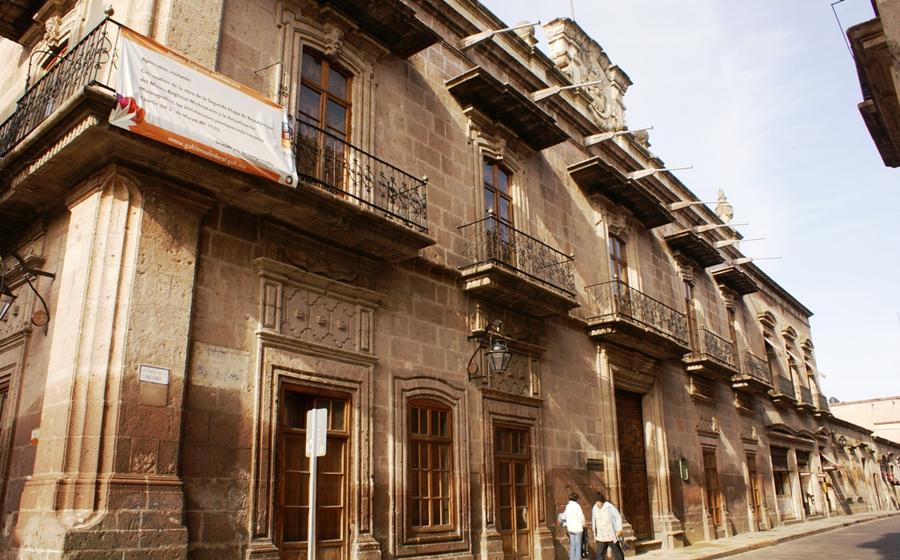
Museo Regional Michoacano
- Museo Regional Michoacano: A Cultural Gem in Morelia
- Unveiling the Museum's History
- Exploring the Architectural Marvel
- A Treasure Trove of Cultural Artifacts
- Pre-Hispanic Masterpieces
- Colonial Art and Religious Splendor
- Contemporary Expressions
- Interactive and Educational Exhibits
- Temporary Exhibitions and Events
- Guided Tours and Audio Guides
- Museum Shop and Bookstore
- Accessibility and Facilities
- Planning Your Visit
- Location and Transportation
- Insider Tip: Hidden Gems
Museo Regional Michoacano: A Cultural Gem in Morelia
Nestled stands a cultural treasure trove—the Museo Regional Michoacano. This magnificent institution is dedicated to preserving and showcasing the rich history and diverse cultural heritage of the region. Founded in 1886, the museum has played a pivotal role in promoting Mexican culture and identity, both nationally and internationally.
The Museo Regional Michoacano is housed in a stunning neoclassical building, which itself is a testament to the architectural heritage of the city. Its grand facade, adorned with intricate carvings and sculptures, hints at the treasures that lie within. The museum's collection is a testament to the cultural diversity and artistic prowess of Mexico. From ancient pre-Hispanic artifacts to colonial-era masterpieces and contemporary works of art, the museum offers a comprehensive journey through the artistic and cultural evolution of the region.
Unveiling the Museum's History
The Museo Regional Michoacano's rich history is intertwined with the cultural tapestry of Morelia and the surrounding region. Its genesis can be traced back to the late 19th century when a group of local intellectuals and historians envisioned a space to showcase the diverse cultural heritage of Michoacán. In 1886, their dream materialized with the establishment of the museum, initially housed in the Colegio de San Nicolás.
Key figures such as Manuel Martínez Gracida, a renowned historian and politician, played a pivotal role in shaping the museum's early collection and mission. Through their efforts, the museum acquired a diverse array of artifacts, ranging from pre-Hispanic relics to colonial-era art and contemporary masterpieces.
Over the decades, the museum underwent several transformations and expansions. In 1910, it moved to its current location, a former Jesuit college, providing more space to accommodate its growing collection. Throughout the 20th century, the museum continued to expand its reach, becoming a renowned center for cultural preservation and education.
Exploring the Architectural Marvel
The Museo Regional Michoacano stands as a testament to the fusion of architectural styles, embodying both the grandeur of the past and the vibrancy of contemporary design. The building's façade, adorned with intricate carvings and wrought-iron balconies, reflects the rich artistic heritage of Mexico. Its spacious interior, with its high ceilings and elegant arches, creates an atmosphere of grandeur and awe. The museum's strategic location, in the heart of Morelia's historic center, further enhances its significance, placing it amidst other architectural gems that showcase the city's cultural tapestry. The harmonious blend of architectural elements in the Museo Regional Michoacano elevates it from a mere repository of artifacts to a work of art in its own right, symbolizing the cultural fusion that has shaped Mexico's identity.
A Treasure Trove of Cultural Artifacts
The Museo Regional Michoacano houses a diverse collection of cultural artifacts that represent Mexico's rich and diverse heritage. Visitors can embark on a journey through time, exploring ancient artifacts from pre-Hispanic civilizations, colonial-era art and religious objects, and contemporary works from local and national artists.
The pre-Hispanic section of the museum showcases a remarkable collection of artifacts from ancient civilizations such as the Purépecha, the Aztecs, and the Tarascan. These artifacts provide valuable insights into the beliefs, customs, and daily lives of these ancient cultures. Visitors can admire intricate pottery, finely crafted jewelry, and ceremonial objects that reveal the artistic and technological prowess of these civilizations.
Pre-Hispanic Masterpieces
Among the museum's most captivating exhibits are the remarkable pre-Hispanic artifacts, offering a glimpse into the rich cultural heritage of Mexico's ancient civilizations. These precious objects, often intricately carved or adorned with vibrant colors, narrate the stories of past societies and their beliefs.
The museum houses an impressive collection of ceramic figurines, stone sculptures, and jewelry, each piece a testament to the artistic prowess and craftsmanship of pre-Hispanic artisans. Notable among these are the exquisite clay figurines from the Tarascan culture, depicting various deities, animals, and scenes from everyday life. These figurines provide valuable insights into the spiritual and social practices of this ancient civilization.
Equally impressive are the stone sculptures, such as the colossal heads from the Olmec civilization. These enigmatic heads, carved from massive boulders, exude an air of mystery and awe, inviting visitors to contemplate the advanced artistic and engineering skills of this ancient culture.
The Museo Regional Michoacano serves as a guardian of these invaluable artifacts, preserving and showcasing Mexico's rich pre-Hispanic heritage. Through these remarkable objects, visitors can embark on a journey through time, connecting with the vibrant cultures that shaped the nation's identity.
Colonial Art and Religious Splendor
The Museo Regional Michoacano houses a remarkable collection of colonial-era artwork that showcases the influence of European styles and techniques, particularly from Spain and Italy. These works, often commissioned by the Catholic Church, adorned churches and religious institutions throughout the region and played a vital role in spreading Christianity.
Among the highlights of the colonial art collection are intricate paintings, sculptures, and religious artifacts that depict scenes from the Bible, portrayals of saints and angels, and representations of the Virgin Mary. The works showcase the mastery of colonial artists in capturing both the beauty and the sacredness of their subjects.
One standout piece is a large oil painting depicting the Last Supper, created by an unknown artist in the 17th century. The painting captures the dramatic moment when Jesus reveals to his disciples that one of them will betray him. The expressions on the faces of the disciples, ranging from shock to sorrow, convey the emotional depth of the scene.
Another notable work is a wooden sculpture of the Virgin Mary, carved in the 16th century. The sculpture, with its serene expression and intricate details, is a testament to the skill and artistry of colonial craftsmen. It is revered by many as a symbol of faith and devotion.
The colonial art collection at the Museo Regional Michoacano provides a glimpse into the artistic and religious traditions of Mexico during the colonial period. These works, infused with European influences and infused with local sensibilities, offer valuable insights into the cultural and spiritual heritage of the region.
Contemporary Expressions
The Museo Regional Michoacano also serves as a platform for contemporary Mexican artists to showcase their talents and creativity. The museum's collection includes a diverse range of contemporary artworks, from paintings and sculptures to installations and mixed media pieces. These works offer a glimpse into the minds and experiences of contemporary Mexican artists, reflecting on modern society, culture, and politics.
The museum's contemporary art collection includes works by renowned Mexican artists such as Diego Rivera, Frida Kahlo, and José Clemente Orozco. These iconic figures played a crucial role in shaping the Mexican art scene and their works continue to inspire and captivate audiences worldwide.
In addition to established artists, the museum also supports emerging and local talent. It provides a space for these artists to exhibit their works and gain recognition. By doing so, the museum contributes to the development and promotion of contemporary Mexican art and ensures that diverse voices are heard.
Interactive and Educational Exhibits
The Museo Regional Michoacano captivates visitors with its engaging and interactive exhibits that cater to all age groups. Immersive displays, multimedia presentations, and hands-on experiences bring history and culture to life. Educational programs and workshops delve deeper into specific themes, fostering cultural awareness and igniting a passion for learning. Interactive elements encourage visitors to actively engage with the exhibits, creating a memorable and enriching experience.
Temporary Exhibitions and Events
The Museo Regional Michoacano is not just a repository of permanent exhibits; it also hosts a dynamic array of temporary exhibitions and events, adding a fresh and ever-changing dimension to the museum experience. These exhibitions explore diverse themes related to Mexican art, history, and culture, delving into specific periods, artists, or cultural phenomena. Visitors can expect to encounter a wide range of artistic expressions, from traditional crafts and folk art to contemporary installations and experimental works.
Special events, lectures, and workshops are also organized regularly at the museum, inviting experts, scholars, and artists to engage with the public and share their insights and knowledge. These events provide opportunities for visitors to delve deeper into Mexican culture, learn about the latest trends in contemporary art, and participate in hands-on activities and workshops.
Through these temporary exhibitions and events, the Museo Regional Michoacano remains a vibrant and dynamic cultural hub, constantly evolving and offering new perspectives and experiences to its visitors. Collaborations with other cultural institutions, both national and international, further enrich the museum's programming and contribute to its reputation as a leading center for cultural exchange and dialogue.
Guided Tours and Audio Guides
To enhance your experience at the Museo Regional Michoacano, guided tours are available in various languages, led by knowledgeable docents who can provide in-depth insights into the museum's collection and history. Alternatively, self-guided tours with audio guides are offered, allowing you to explore at your own pace and listen to detailed commentaries about specific exhibits. These tours help bring the museum's artifacts to life, ensuring a deeper understanding and appreciation of Mexico's rich cultural heritage.
Museum Shop and Bookstore
The Museo Regional Michoacano houses a well-curated museum shop and bookstore, offering a delightful array of souvenirs, merchandise, and publications to enhance your visit and preserve the memories of your cultural journey. Browse through a diverse selection of postcards, magnets, keychains, and other trinkets that capture the essence of the museum's collection. Support local artisans and promote cultural preservation by purchasing unique handcrafted items, such as pottery, textiles, and jewelry, that showcase the region's vibrant artistic traditions.
The bookstore is a treasure trove for those seeking to delve deeper into Mexican art, history, and culture. Discover a carefully curated selection of books that explore the region's rich heritage, from ancient civilizations to colonial art and contemporary expressions. Whether you're an art enthusiast, history buff, or simply seeking a deeper understanding of Mexico's diverse cultural tapestry, the museum's bookstore offers a wealth of knowledge and inspiration.
Accessibility and Facilities
The Museo Regional Michoacano is committed to accessibility and inclusivity. The museum is equipped with wheelchair ramps and elevators, making it fully accessible to visitors with disabilities. Spacious corridors and designated seating areas provide a comfortable environment for all visitors. Restrooms and lockers are conveniently located throughout the museum, ensuring a hassle-free experience. Visitors can also seek assistance from the multilingual staff at the information desk, who are ready to provide guidance and answer any questions. These thoughtful amenities and services ensure that everyone can enjoy and appreciate the museum's cultural treasures without any barriers.
Planning Your Visit
To fully immerse yourself in the wonders of the Museo Regional Michoacano, plan your visit carefully. The museum's doors are open from Tuesday to Sunday, welcoming visitors between 10 am to 5 pm. With a modest admission fee, you can embark on a journey through Mexico's rich cultural heritage.
To grasp the museum's essence, allocate around two to three hours for your exploration. This will give you ample time to appreciate the diverse exhibits, delve into the interactive displays, and soak in the cultural atmosphere.
For a more intimate experience, consider visiting during the weekdays to avoid the weekend crowds. Prior booking is not required, but it's recommended for groups to ensure a smooth entry. Check the museum's website or contact them directly for any special arrangements or group discounts.
Location and Transportation
The Museo Regional Michoacano is situated in the heart of Morelia, within easy reach of other notable attractions. Its address is Calle Guillermo Prieto 176, Centro Histórico, 58000 Morelia, Mich., Mexico. To get there, you can take advantage of the city's efficient public transportation system. Several bus routes stop nearby, making it a convenient option. Alternatively, taxis are readily available and offer a comfortable ride to the museum.
If you prefer to explore at your own pace, consider renting a car. Ample parking is available in the vicinity of the museum, ensuring a hassle-free visit. By car, you can easily integrate the museum into a broader itinerary, allowing you to explore Morelia's other cultural treasures and natural wonders. The city's central location makes it an ideal base for day trips to nearby towns and villages, offering a diverse range of experiences.
While in Morelia, take the opportunity to visit the nearby Templo de San Francisco, a stunning example of Baroque architecture, or stroll through the bustling Plaza de Armas, the city's main square. Immerse yourself in the vibrant local culture by savoring the delicious regional cuisine at one of the many restaurants in the historic center. Morelia offers a harmonious blend of history, culture, and natural beauty, making it a captivating destination for any traveler.
Insider Tip: Hidden Gems
Beyond the main exhibits, the Museo Regional Michoacano holds hidden treasures waiting to be discovered. In a secluded corner, find a small room dedicated to the fascinating history of puppetry in Michoacán. Elaborate marionettes and shadow puppets narrate enchanting tales of Mexican folklore.
Strolling through the courtyard, don't miss the serene beauty of the garden. Amidst lush greenery, sculptures by local artists blend harmoniously with the colonial architecture, creating a tranquil oasis for contemplation and reflection.
For an authentic Morelia experience, venture outside the museum walls. Just a short walk away, savor the flavors of traditional Mexican cuisine at "La Antigua Fonda La Josefina." This family-run restaurant serves up mouthwatering dishes that showcase the region's culinary heritage.
Morelia offers a vibrant cultural scene beyond the museum. Attend a performance at the Teatro Ocampo, a stunning 19th-century theater that hosts concerts, plays, and dance recitals. Afterward, immerse yourself in the city's lively nightlife by exploring the bars and clubs along Calle Real, where locals and visitors mingle to the rhythm of live music.
As a travel blogger, I'm always on the lookout for hidden gems, and Morelia has plenty to offer. Whether it's discovering forgotten corners of the museum, savoring local delicacies, or immersing yourself in the city's cultural pulse, there's something magical waiting around every corner.
